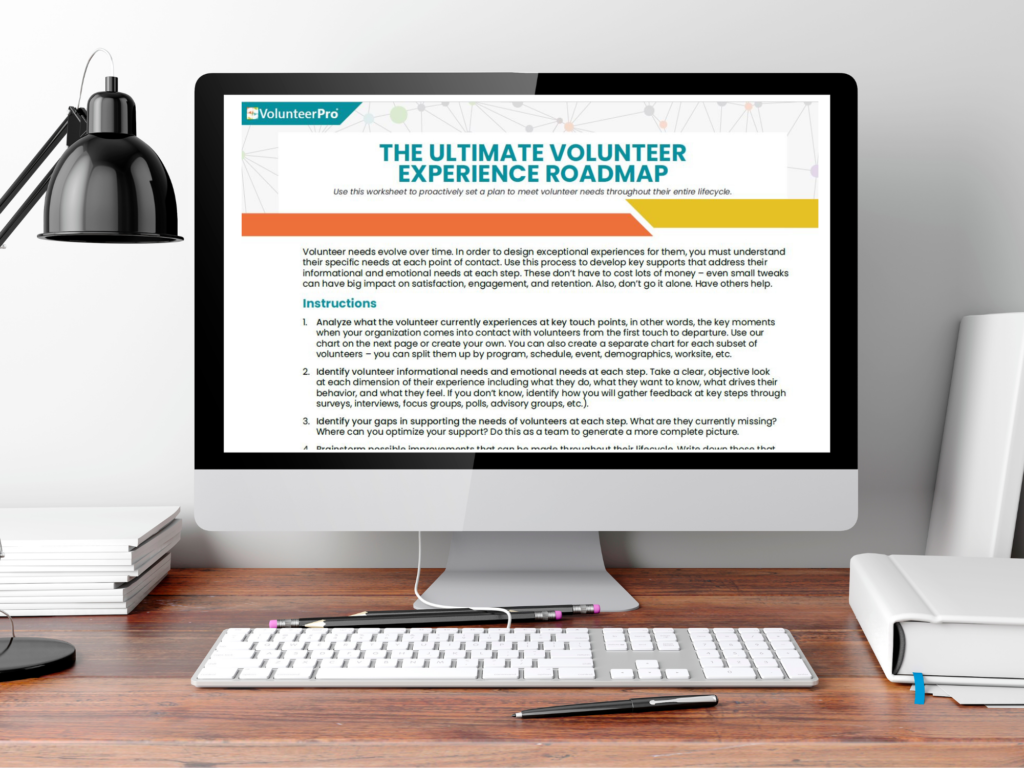4 Strategies to Help You Make Better Volunteer Placements
Learning to match volunteers isn’t rocket science, but it does take a little forethought. You need to know what you are specifically looking for and find out what each volunteer has to offer. Luckily, we have four strategies to share with you that can help you make better volunteer placements.
When volunteers can tap their true strengths (these are not always those they use at work), they feel more fulfilled and have a greater sense of personal volition and agency.
In the words of the father of modern workplace motivational theory, it’s the job of leaders, not those they recruit, to design a work environment that inspires.
How do you do that?
Design volunteer placements that offer the opportunity for supporters to BOTH do their best AND strategically serve your mission.
Below are four ways to do just that.
Strategy #1: Use KSAs for Better Volunteer Placements
KSAs describe the competencies volunteers need to be successful on the job. They can also include key attitudes you expect once they join.
Your list may include minimum qualifications that must be achieved before a volunteer will be appointed to a role. Others can be learned on the job through training and mentoring.
Knowing when the competencies are needed is as important as knowing which KSAs you are seeking. So, know which is which before you recruit.
Consider listing KSA skills from three different “buckets” —
Basic Skills
- Accurately describing the organization’s mission & programming
- Demonstrating commitment to the program
- Working with others, both as a leader and a follower
- Maintaining a positive attitude
- Using self-care strategies to handle stress
- Managing one’s own time
People Skills
- Exhibiting compassion and caring for others
- Listening attentively to others
- De-escalating angry people
- Accepting and learning from coaching and feedback
- Maintaining appropriate professional boundaries
- Effectively teaching others to do something, one-on-one
Technical Skills
- Using a computer (internet, software, social media, etc.)
- Developing relationships with community partners on behalf of the agency
- Writing and designing communication materials using plain language
- Operating a vehicle safely
- Following the established protocols for a specific, assigned role
Strategy #2: Tap Into Volunteer Emotions
Leaders of volunteers work hard to find, engage, place, motivate, and retain volunteers and there are hundreds of ways to do this.
But, what ultimately makes a volunteer choose your organization and the roles you offer? Their emotional brain!
The primitive and emotional brain is what triggers empathy and develops a person’s willingness to help. So, how can we tap into that emotional brain? How can we use it to make better volunteer placements?
There are six things that stimulate the brain and by using tactics that directly light up the brain in these areas, you can reach volunteers on an emotional level and help them become more deeply engaged with your organization, right from the start of their placement as a volunteer.
Here’s what you should know about reaching the emotional brain:
1. Centered on Self – Explain direct rewards. Use “you” in your communications.
2. Clear Contrast – Use before/after and us/them.
3. Tangible Input – Communicate simple, concrete ideas.
4. Beginning & Ending – Focus on first touches and your volunteer placement strategy.
5. Visual Stimuli – Use photos and video whenever possible.
6. Emotion – Share powerful stories of change.
When you use each of these tactics in your recruitment and onboarding strategy, you are more ale to capture the brain’s full attention, even in a distracted world. When people are paying attention, they will likely be attracted to a role that appeals to their interest level and makes sense. This extra care can help improve the suitability of your volunteer placements.
Strategy #3: Volunteer Onboarding for Better Volunteer Placements
Successful volunteer onboarding and deep volunteer engagement don’t happen by chance. It takes a thoughtful, multi-layered strategy to convert joiners to stayers and to set the stage for future leadership.
We often think of onboarding as simply training volunteers on policies and procedures, then placing them, job done. But, effective volunteer induction is more than that.
Even after they have been recruited, volunteers will continue to observe the organization and the people who work there (paid and volunteer alike). Commitment is a process not a destination. Even after volunteers join, they are still deciding about whether they will stay.
They wonder — Does this organization match my values? Do I feel included? If this a well-run outfit? Can I make a real difference here? Is it worth my time? The answers will influence how much they decide to invest and what they believe they can accomplish in partnership with you.
There are four ways you can integrate volunteer onboarding into your volunteer placement strategy in a way that boost engagement and encourages commitment:
1. Interpersonal Connections
People commit to causes because they feel a connection to the people in them. Purposefully cultivating connections through mentoring, peer socializing, staff teambuilding, etc. can go a long way toward making newcomers feel welcome and quickly integrate them into the whole.
2. Organizational Culture
New volunteers also need to be provided clues about “how we do things around here” in their induction process. This includes sharing clear information about how the organization’s mission, vision, and values play out in the real world, not just on a piece of paper.
It also helps for new volunteers to have a clear picture of team member roles throughout the organization and, of course, understand their scope of work and level of responsibility. Offering simple talking points volunteers can use to educate others about the organization’s work, also helps newcomers begin to contribute by raising community awareness from the get-go.
3. Early Training Support
Although it may be weeks before the volunteer starts their first shift, their orientation should start on Day One, they day they are appointed or given a training date.
Setting up ways to deliver bite-sized digital content is one way to start the acclimation process early. Helping volunteers develop personal development plans for learning will help them better map their new context and take responsibility for learning goals.
4. Exposure to Strategy
Finally, transparently sharing agency and program-level aims and objectives, disclosed in layers, so as not to overwhelm, can help volunteers align their goals with those of the organization and, at the same time, identify hidden skills and talents they might bring to the table.
This is also an excellent time to gather new insights around current strategies from volunteers with fresh eyes and perspectives.
Strategy #4: Plot Your Volunteer Roles
If you are a leader of volunteers, the fastest way to get a jump on each year is to plot out your agency’s volunteer roles in a purposeful way.
If you’re tired of spinning your wheels, taking this one simple step can reduce your stress. It’ll give you peace of mind that you’ve got things figured out. You’ll have a plan in place and a global view of what you’ll achieve.
And this knowledge will give you a solid feeling of confidence.
Your own sense of empowerment is more vital than you think. People (like you) who must rely on their ability to influence others for a living, without positional power to lean on, have a tough row to hoe without a sense of their own efficacy.
Having a plan will strengthen your outlook and reassure those around you.
Creating Your Plan for Volunteer Roles
When you start your planning, set up meetings with everyone with whom you will placing volunteers in the coming year.
This is how and when you start setting limits on your time and energy for the coming year. So, you need to be clear, direct, and helpful. You are looking forward to “taking their orders” (their words, not yours) and brainstorming the best ways to utilize this fantastic human resource your agency is so grateful to have.
Let them know that THIS is the time you will be planning, not next month, next year, or when they decide they need volunteers. Let them know that you will be prioritizing your volunteer recruitment around the roles that are on your plan. If the role isn’t on the list, you may or may not have time to devote to it.
But the point of planning is to give your co-workers the best support you can and to have the breathing room to identify volunteers that will have the best opportunity of success in their department. You have limitations and so do they. It’s time to work together for mutually beneficial solutions.
Brainstorming Role Types
Work with your colleague to brainstorm a list all the traditional volunteer roles you need to fill (or maintain) for the coming year. Ask them to identify the minimum skills and abilities volunteers will need to be successful in each specific role. If screening requirements vary by role or department, record and confirm them.
Then, confirm date the role is expected to start, or get their best guestimate. If you are continuing from the previous year, list the first shift date of the year. Then ask them to nail down the schedule for each role and the minimum commitment they will accept.
Require specificity. There’s nothing worse than having someone claim their open to “whatever the volunteer wants” only to find out later that staff resent volunteers not showing up when needed.
This may seem like a lot of info to gather, but you’ll be happy you have it for your planning. It’s much better than going back and forth and spinning your wheels.
Organizing Roles
After you brainstorm the role type, list all agency programs (or departments) and the number of volunteers engaged by type. If the department does not engage volunteers, list them and put zeros in each box.
This is how you will gently apply peer pressure to expand volunteer involvement across your agency.
This sheet will help everyone see, immediately, how volunteers are utilized and where the opportunities and gaps live. Everyone will be able to quickly assess whether roles are diversified across the volunteer spectrum. And you’ll be giving public kudos to those departments who are encouraging deep involvement.
Communicate Your Plan
Once your plan is complete, communicate the heck out of it!
Break down the volunteer numbers for everyone in simple terms – the total number of volunteers that you plan to involve in the coming year. If there’s an increase, describe that.
If you want to really impress your colleagues, calculate the total number of FTE employees the estimated total of your organization’s volunteer hours would equate to.
Then start talking time and resources needed to get the job done.
FREE Tool: Let Us Help Move Your Mission Forward
A tremendous amount of time and energy goes into finding and selecting volunteer talent.
Consider how a purposeful, integrated new volunteer induction process might ensure deeper commitment and foster future volunteer leaders.
Use our Volunteer Experience Roadmap to map a step-by-step new volunteer journey and see how it can help propel your mission forward.









